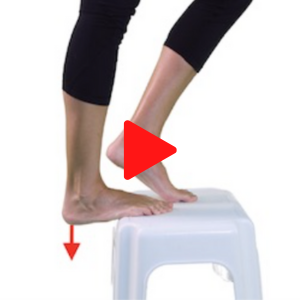Achilles Tendinopathy Rehab: Evidence-Based Exercises and Loading Guidelines
Exercise remains the cornerstone of rehabilitation for both midportion and insertional Achilles tendinopathy. Yet, while most clinicians prescribe heel raises, there’s still substantial variability in how these exercises are performed to optimize tendon adaptation.
A new Delphi consensus published in the British Journal of Sports Medicine surveyed leading researchers and clinicians to identify which exercise parameters have the greatest influence on outcomes in AT rehabilitation. (1)
Four parameters emerged as critical for midportion Achilles tendinopathy, and three for insertional Achilles tendinopathy.
Let’s break down what this means for clinical practice.
1. Exercise Intensity for Achilles Tendinopathy
Why it matters: Tendon remodeling is strain-dependent. Mechanical loading must be high enough to induce structural adaptation.
Experts agreed that 70–90% of 1RM (Repetition Maximum) appears optimal for tendon adaptation. This level of load helps achieve the 4.5–6.5% strain window shown to stimulate collagen synthesis and improve tendon structure.
However, contraction intensity should always be viewed relative to the patient’s loading history.
Athletes accustomed to resistance training may tolerate higher loads sooner.
Sedentary individuals may require a gradual ramp-up in intensity.
Clinical takeaways:
Bodyweight heel raises alone are insufficient to drive meaningful tendon adaptation.
Progress from moderate to heavy loads (70–90% 1RM) as tolerated.
2. Time Under Tension in Achilles Rehab
Why it matters: The tendon’s response depends on how long the strain is applied. Rapid or ballistic contractions transmit a less effective remodeling stimulus.
Experts emphasized that slow, controlled contractions (~6 seconds per repetition) are most effective for tendon adaptation, typically 3 seconds concentric and 3 seconds eccentric.
This aligns with protocols like Heavy Slow Resistance and Silbernagel’s combined loading, which emphasize prolonged loading durations early in rehab.
Clinical takeaways:
Each contraction should last ~6 seconds total (3 seconds up, 3 seconds down).
Slow tempos support early-stage remodeling; faster tempos can be added later to develop power and prepare for sport-specific demands.
3. Sets and Reps for Achilles Tendon Exercises
Why it matters: Total loading volume (sets × reps × intensity) influences both tendon and muscle performance.
While there’s no universally “optimal” prescription, most protocols begin with 3–4 sets of 15 reps at moderate loads, then progress to 3–4 sets of 6–8 reps as intensity increases.
As load rises, total volume can be reduced to maintain appropriate recovery and avoid overload.
Clinical takeaways:
Begin with higher reps (12–15) at moderate load, then reduce reps as load intensity increases.
Use pain monitoring to guide progression: pain ≤5/10 during exercise, no next-day flare-up, and no disruption to sleep.
💡 Deeper dive: Here’s a quick guide on how to structure loading for optimal tendon adaptation, highlighting the ideal intensity, tempo, and duration to restore Achilles tendon strength and resilience.
4. Types of Achilles Loading Exercises
Why it matters: Eccentric-only loading is not superior to other contraction types.
While eccentric training (Alfredson protocol) remains foundational, current evidence supports using all contraction types depending on phase and deficits:
Isometric: Useful early loading and in fear-avoidance presentations.
Concentric–Eccentric: Core loading strategy to build capacity and control.
Plyometric: Integrated later to restore function and prepare for high-load, sport-specific activities.
Clinical takeaways:
Incorporate multiple contraction types across rehab phases.
Progress systematically: isometric → slow isotonic → plyometric.
Here are three key exercises to help you implement these Achilles loading strategies in practice.
ChiroUp subscribers can access and review the entire Achilles Tendinopathy protocol and the associated exercises from their clinical skills database.
Practical Considerations for Insertional Achilles Tendinopathy
For insertional cases, range of dorsiflexion was also identified as a key variable. Excessive dorsiflexion increases compressive load between the tendon and calcaneus.
Early phase: Limit dorsiflexion to neutral or mid-range positions.
Later phase: Gradually reintroduce full dorsiflexion as tolerance improves.
Clinical Implications
While Achilles rehab is often simplified to “just do heel raises,” this consensus makes clear that how you load matters as much as what you load.
Key clinical principles:
Prioritize contraction intensity — aim for 70–90% of 1RM.
Emphasize time under tension — each contraction lasting ~6 seconds.
Incorporate a variety of contraction types based on phase and deficits.
In short: load heavy, move slow, and tailor the program to the patient’s presentation and tolerance.
Effective Achilles tendinopathy management goes beyond prescribing heel raises—it’s about knowing how to load, progress, and monitor the tendon for lasting change. That’s where clinical tools like ChiroUp make a difference. With evidence-based protocols, exercise parameters, and patient education resources built right into your EHR, ChiroUp helps chiropractors deliver more consistent, research-driven outcomes.
If you’re ready to streamline your Achilles rehab plans and enhance patient results, book a demo today.
-
Demangeot Y, O’Neill S, Degache F, et al. Exercise parameters to consider for Achilles tendinopathy: a modified Delphi study with international experts. Br J Sports Med. 2025;59(10):1337–1349. doi:10.1136/bjsports-2025-110183.



